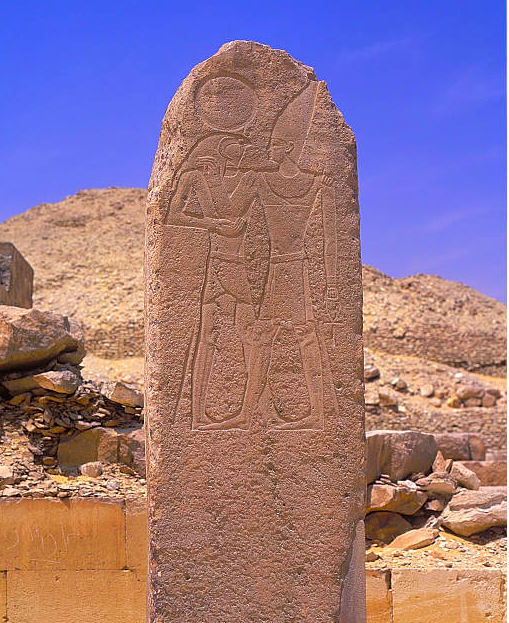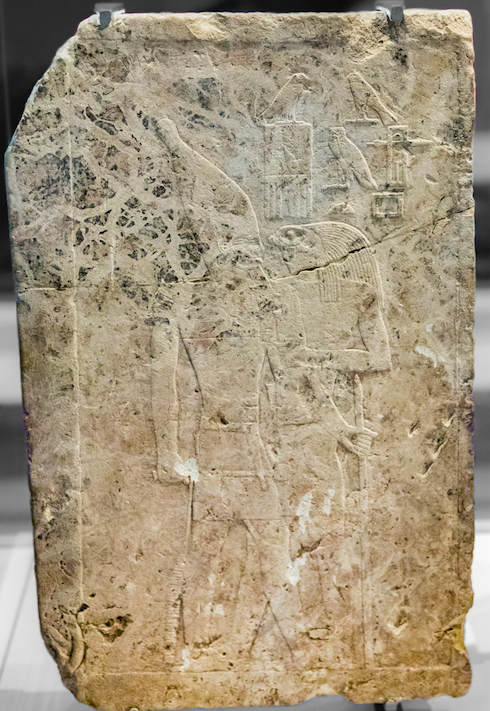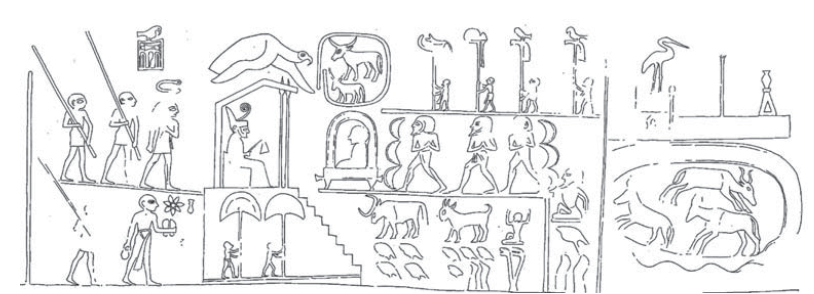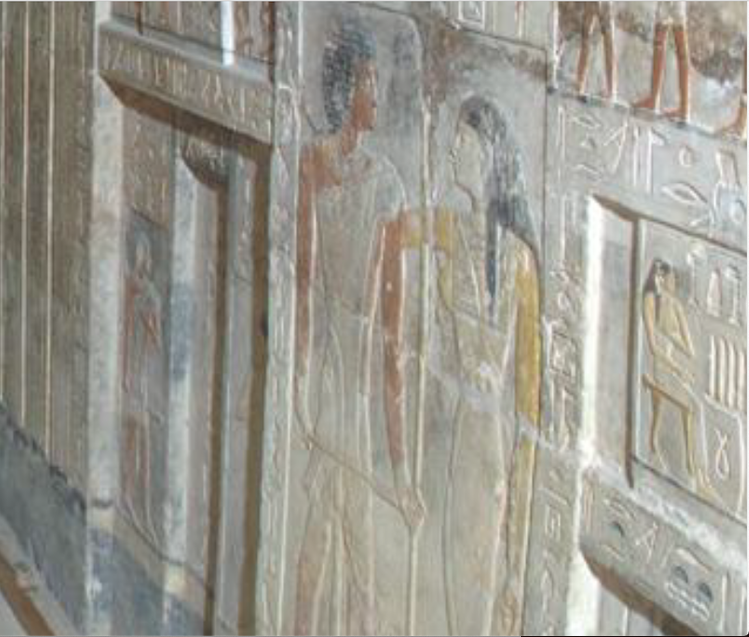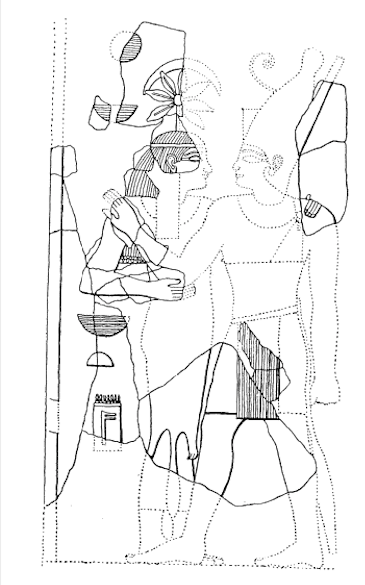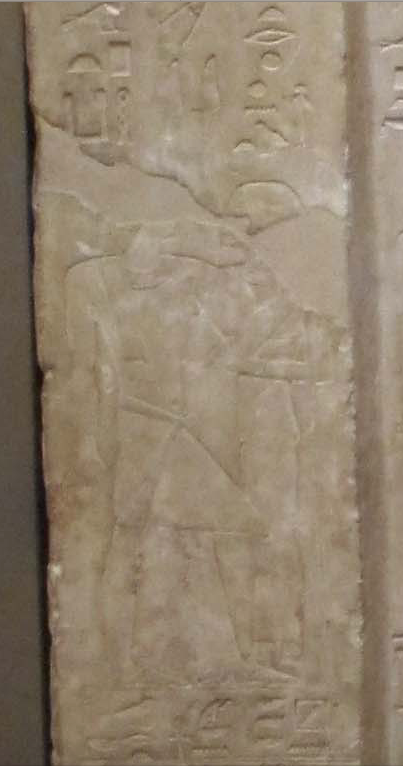perpetual unity of the ancient Egyptian marriage
The two 'bas' and the perpetual uniqueness of the ancient Egyptian marriage.
The union of the two Horus/two ‘bas’ (Osiris and Horus are called ‘bas’, cf. TP 356), allowed the formation of a single Horus (TP 667A)/"the one with the two ‘bas’" (TS 335, LdM 17), united conjugally to "heaven", to the "gods", to "those who are in Mendes", the divinised men (wife of Horus).
This union of the two ‘bas’ was represented in two ways:
1)Either Horus N (serekh) is united to Horus with the head of a hawk "in the castle (=wife)",
2)Either this same Horus N (serekh) is united to the castle (=wife) of Horus (=?wt-Hr = Hathor) or another goddess.
In both cases, it is the same marriage because the goddess/castle formed the "limbs" (TP 260, 419) of Horus with the head of a hawk "in the castle". This marriage consisted of the union of Osiris/Horus N with Horus, the latter "filling" the former who became Horus.
This alliance between Horus N (serekh) and Horus "in the castle (=the gods, wife)" replaced an old one:
That of the gods (wife) whose "white sandals (?bwt ??t), clothes (mn?wt)", were "thrown (sti)", "rid (sz?)" (TP 518) by the gods themselves, because they did not have a prosperous heart, as long as N had not "gone down (union)" on the road called "prosperity of the heart" to be their husband (for this spousal status, see below).
TP 518 (P/Cn/W 16 M/Cm/E 23 N/Cm/E 22)
« N found the gods standing (gm~n N n?rw ???w),
wrapped in their clothing (=wife) (knmw m mn?.wt=sn),
their white sandals (=wife) at their feet (?bwt=sn ??t r rd.wy=sn).
They threw their white sandals (former wife) on the ground s?~jn=sn ?b.wt=sn ??t jr t?,
and got rid of their clothes (former wife)(sz?~jn=sn mn?wt=sn)
We are not happy (litt. sound of heart) until your descent (=marriage)'' they say (n w?? jb=n jr h?t=k, jn=sn)
No sooner had you spoken, than the pavement/dromos (=wife, = Isis cf. infra) were made stable for you (?d~n=?n, jsmn~n=?n s?m)
Prosperity of the heart' (=wife) is the name of this causeway/dromos to the north of the field of offering (s?m w??-jb, rn n s?m pw m?t s?t ?tp (det. bread lying horizontally).
Rise up, Osiris, and command N for those who are on the causeway 'prosperity of the heart' (=wife) north of the field of offering (??? jr=k Wsjr, w?=k n n ?rw s?m s?m w??-jb m?tj s?t ?tp ),
as you commanded Horus to Isis (=mother and wife, compared to the causeway 'prosperity of the heart') on that day when you made her pregnant (mj w?=k ?r n ?st hrw sjwr~n=k s jm)».
In other words, the sandals and clothes symbolised the alliance of the gods (=wife) with another husband who did not make the heart of the gods prosperous (wife).
The gesture of throwing them to the ground meant a breaking of the covenant with this evil god-husband.
Like the sandals and the garments, the pavement 'prosperity of the heart' symbolised, as its name suggests, the heart of the gods, but this time the heart of the gods prospers, and thus the gods themselves form a new covenant as a (remarried) wife, with Osiris N (himself remarried after death, as Osiris/Horus) (TP 518 P/Cn/W 16 M/Cm/E 23 N/Cm/E 22).
Osiris N was indeed the husband of the gods (wife), because, according to the rest of the formula, N is "ordained (w?)" by Osiris, to those on the causeway (=the gods), exactly "as Osiris ordained Horus to Isis when he made her pregnant".
Now Isis, to whom the gods on the causeway are compared, was the mother of Horus but also his wife; in fact, Horus was called "Bull (=husband) of his mother" from the Middle Kingdom [1]. Moreover in the Texts of the Pyramids, the mother was also the wife: Isis surrounded Horus as the liquid firmament (qb?w), the field of the offering "in" or "within" which Horus "drank and ate" (TP 518 §1200 a,b,c), whereas it was he who founded them (snty) as his wife (TP 518 1196b).
N is therefore ordained in marriage to those on the causeway, compared to Isis, wife and mother.
Thus the prosperity of the heart meant the joy of the wife (gods) with her husband (Osiris/Horus N serekh).
This prosperity of the heart, all spousal, was symbolised by the white sandals, the clothes, the pavement of the gods-wife of N.
Other formulas illustrate the break made by a wife (the gods) from a god other than N, so that she could remarry N :
In formula 509 (P/Cm/E 71 N/A/S B3), Osiris N as a bull "overthrows the ramparts (=wife) of Chou (husband) (sšn znbt šw)", "§1125a so that he (=N) stands in his empty place (jm st šwt) (=wife) which is between the two great gods".
In the formula TP 255, Chou is described as "the detestable of construction (=alliance) (?b? qd), the detestable of form (=alliance) (?b? jrw)". And he is asked to "chase you out of your place (=wife) (jdr ?w ?r st=k), put your badge (your dignity, wife) down for this N (w??=k s??=k r t? n N pn)".
If this is not done, N "will strike the arms of Cabbage carrying Nut (=wife), and N will place his shoulder (as a bull) in this rampart (=wife) on which you (=Cabbage) rest (your shoulder) (wd k? N pn rmn=f m znbt tw rmnt=k r=s)".
The empty place (wife) could also be that of Ra (husband), whom Osiris N chased away to take his place, according to the formula 267 (W/A/S) :
"§366b he (=N) flies as a bird (jp?=f m ?pd),
he poses as a beetle (?nn=f m ?pr),
on the empty throne in your boat, O Ra (m nst šwt jmyt wj?=k, R?)".
Then this is commanded to Ra :
"§367a stand up, withdraw (litt. hunt yourself) (???, jdr ?w),
you who no longer know (= breaking of the covenant) reed-filled (= the gods, wife), j?m jwt
that this N can sit (= union) on your seat (?ms W pn m st=k),
and row (union) in the sky, in your boat, Ra! ( ?nny=f m pt m wj?=k R?) ".
Thus Ra is summoned to separate himself from the wife (empty throne, reed-filled, boat) that he no longer "knows", i.e. with whom he is disengaged, so that N can sit on it (= marital union, remarriage), row on it.
Other formulas illustrate differently the necessity of breaking away from the wife in order for her to remarry: In formula 476, a scribe (sš) is ordered to "crush (s?)" his "palette (mn??)", "break (?bs)" his "brush (?r)", "unroll, hnn" his "scrolls (m??wt)".
Now these objects at the scribe's disposal are metaphors for the wife. Indeed, "the scroll of the god" (TP 250), means that the scroll belongs to the god, just as the wife belonged to her husband.
Moreover, when N is called "the scribe of the book of the god" (TP 510), the belonging of the "book" (wife) to the scribe N and to the god, recalls the link of the wife (book) to her husband N identified with the god who has the same wife.
These objects, palette, brushes, scrolls, represent the wife well, for according to the rest of formula 476, the scribe, by separating his material, immediately loses his place/throne (st), another symbol of the wife. In fact, Ra is charged with "driving out (dr)" this scribe from his place and putting N in his place (=the old bride who has become the new bride) so that N is white (b?q) (=divine), having the wife/place and carrying the staff ?bt (=wife).
We can see that a wife had to be "destroyed", removed from her former husband, in order for N to be able to marry this former wife (remarriage for her but also remarriage of N since N was Osiris, former husband, dead and became Horus (new husband) on the serekh (temple, wife)).
Reciprocally, it is the gods (wife) who could be bad: it is said elsewhere that the father of N (=N) had to "make his heart (= alliance of N with the gods (wife))", "another (heart) having been taken away for him, (ky šdy n=f)", because this heart, "opposed, ??k" to the father of N "going out to heaven (= immortality), so that he waded in these sinuous rivers (rhn=f m nnwt n??). "(TP 512 P/Cm/W 55 N/Cm/W 66).
This heart was a covenant of N with evil gods (wife), because they left N on the ground. On the contrary, the alliance of N with the gods Anubis and Geb, allowed N, at the same time to "keep the earth and rule the spirits akhu", to be purified and divinised, stable, to "cross the sky", to be "among the gods gone for their kaou", to appropriate the akh, luminous spirit, according to the end of the formula ("go in your spirit akh") (TP 512).
Thus to enter into a new alliance/marriage, a break with the old one was necessary, either by death or divorce. Hence the perpetual uniqueness of marriage, i.e. the impossibility for a husband to have several wives simultaneously (polygamy), and the imperative for both spouses to marry successively, after divorce or death of one of the spouses.
This fundamental aspect of matrimonial law was particularly well expressed from the New Kingdom onwards, in a letter (practice text) and a legal text :
- in a letter (P. BM 10416) dating from the New Empire and coming from Deir el-Medineh. The "mistress" of a married man is strongly advised to take the latter to court with his wife in title, so that he may take the oath of divorce and marry his "mistress":
"(vs. l. 8-10) If the heart of this (married) man is for you (=the mistress) (jnn jb n p?y rm? r=t), let him go to court with his wife (jm ?q=f r t? qnbt jrm t?y=f ?mt), let him take the (divorce) oath and come to your house (=remarriage), mtw=f ?rq=f, <10> mtw=f jy r p?y=t "[2].
- in a law on alimony contracts, and more precisely, on the inheritance of children from two successive (post-divorce) wives of their father. This law was cited in P BM 10591 (family archives of Siout, including a trial from the Ptolemaic period), and was called the 'law of the year 21'.
It was probably promulgated under Amasis (XXVIth dynasty).
Indeed, in P. BM 10591, the pharaoh is not named, but he can only be a pharaoh (the lagid king of the time did not reign for as long); this pharaoh can only be Amasis, the last legislator according to Herodotus.
Moreover, it is under his reign that the food contracts mentioned in this law appear [3].
3] Here is the content of this law:
"If a man marries (litt. sits with) a woman (j-jr rm? ?ms jrm s-?mt),
and he writes a feed contract for her,
and he has a son from her, and he divorces her (litt. he throws her away, mtw=e ?wy.?=s),
and he marries (litt. sits with) another woman (mtw=f ?ms jrm gr s.?mt),
and he writes a feed contract for her (mtw=f s? n=s s?n?),
and he has a son from her (nty-jw šr ?pr n=f jrm=s),
when man dies (nty-jw p? rm? n rn=f mwt), his property (n?y=f nkt.w),
they are given to the children of the previous wife (j-jr ?r tw=w st n n? ?r?.w (n) t? ?mt)
for which he has previously written a feed contract (r-sš=f n=s r s?n? n ??t)" [4]
This perpetual uniqueness of marriage was also affirmed by a fact attested as early as the Old Kingdom but also during the 3000 years of the institution of the ancient Egyptian marriage:
It was the god who "ordered (w?)" or sealed conjugal love, that is to say that he divinized this love by making it "like that of Horus with his mother Isis" (TP 518), or like that of Horus/Osiris N/pharaoh/ba/the two bottoms, with his people (divinized men=Isis, the sky).
Since the wife of Horus is compared to his (=d'Horus') only and divine mother, Isis (TP 518), it follows that the marriage was perpetually unique. This comparison is therefore one more argument in favour of this character of marriage, which is in addition to the other evidence from the list of texts cited above on the necessity of a marriage break-up in order to contract another one.
Furthermore, the fact that the god "orders" the spouses to each other and seals their love in a unique and perpetual manner, it follows that the uniqueness of marriage was a divine seal.
All these religious texts using the terms of the standard marriage, allow us to affirm that the latter symbolised that of Horus with his people (=Isis), at the coronation, on the feast of "we are stable/we remain" (TP 419, 477,480, 518 and TS 335, LdM 17).
Laure de Lamotte©
[1] LGG VII, 2002, p. 259 s.v. « K?-mwt.f ».
[2] Janssen 1988, p. 134-7, pl. 25-28 ; Janssen 1991, p. 28-32, pl. 15-18 ; Wente 1990, p. 203.Neuveu 2001, p. 25-31 ; Gee 2002, p. 17-21.
[3] Johnson 1994, p. 113 ; Allam 1986, p. 73, n. 1.
[4] P. BM 10591 (IIe siècle av. J.-C), rto X, 7-9), cf. , B.x :7-9; cite dans Pestman 1961, p. 44.
Last edited: 03/06/2021
Add a comment


